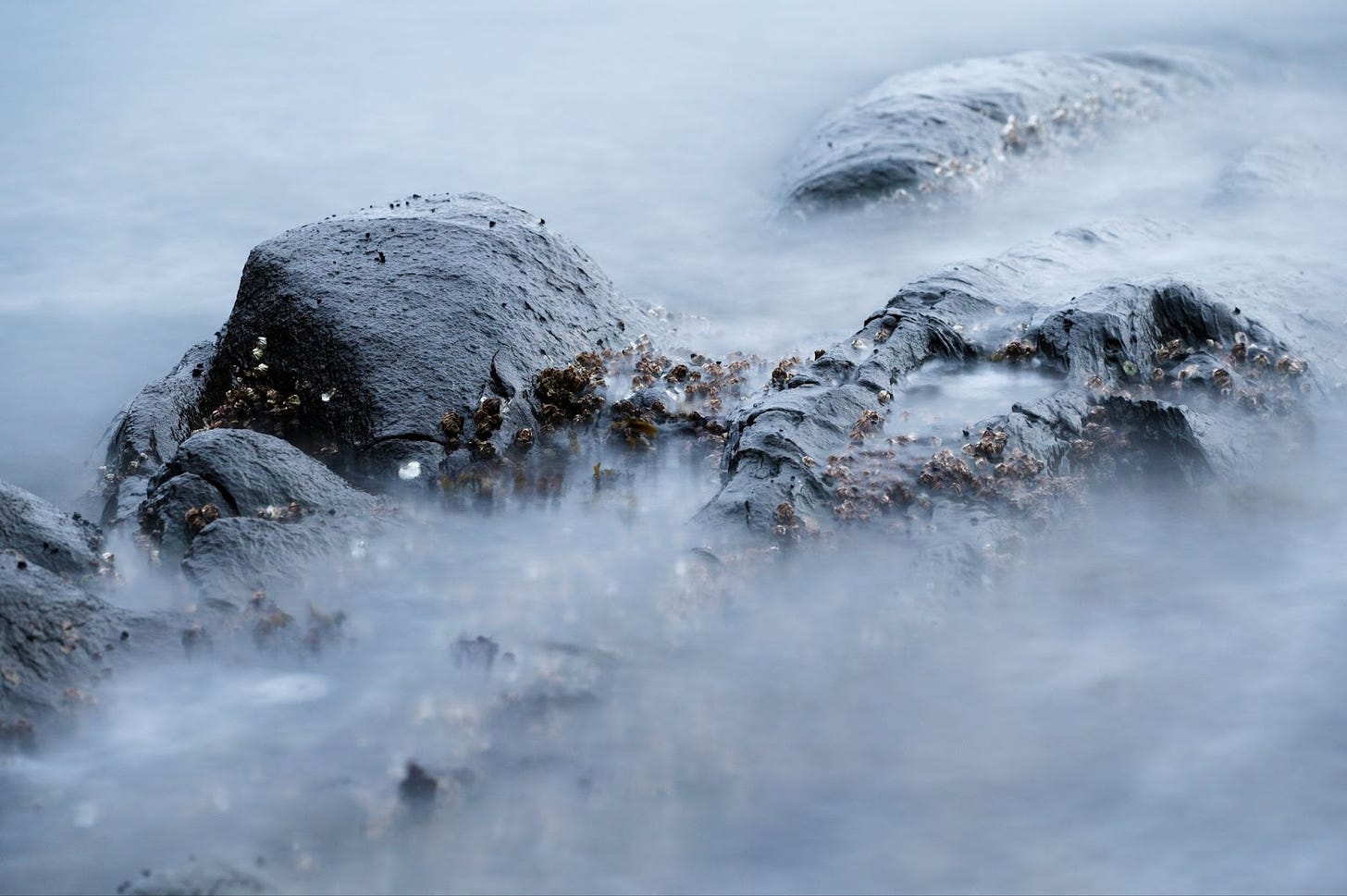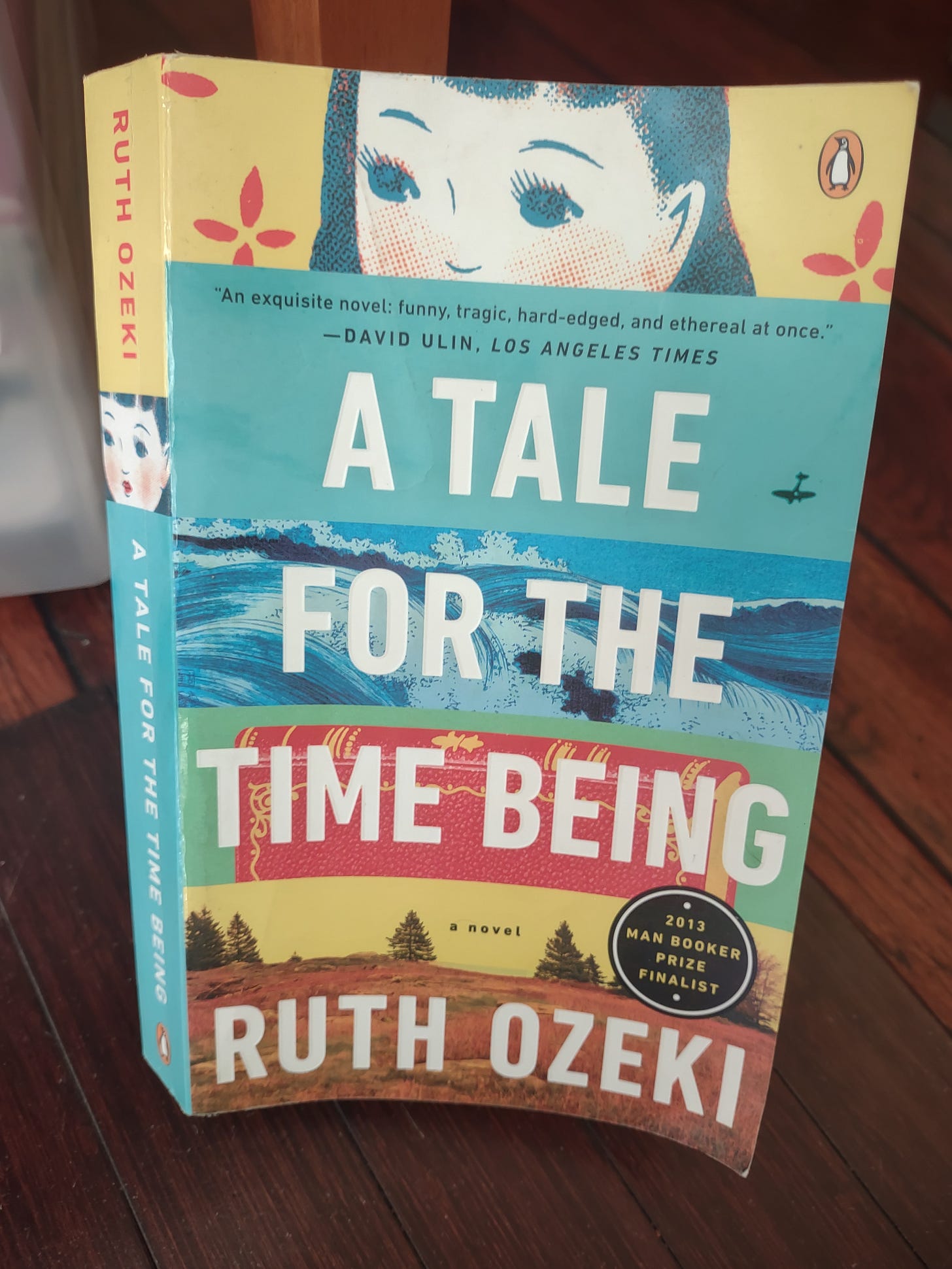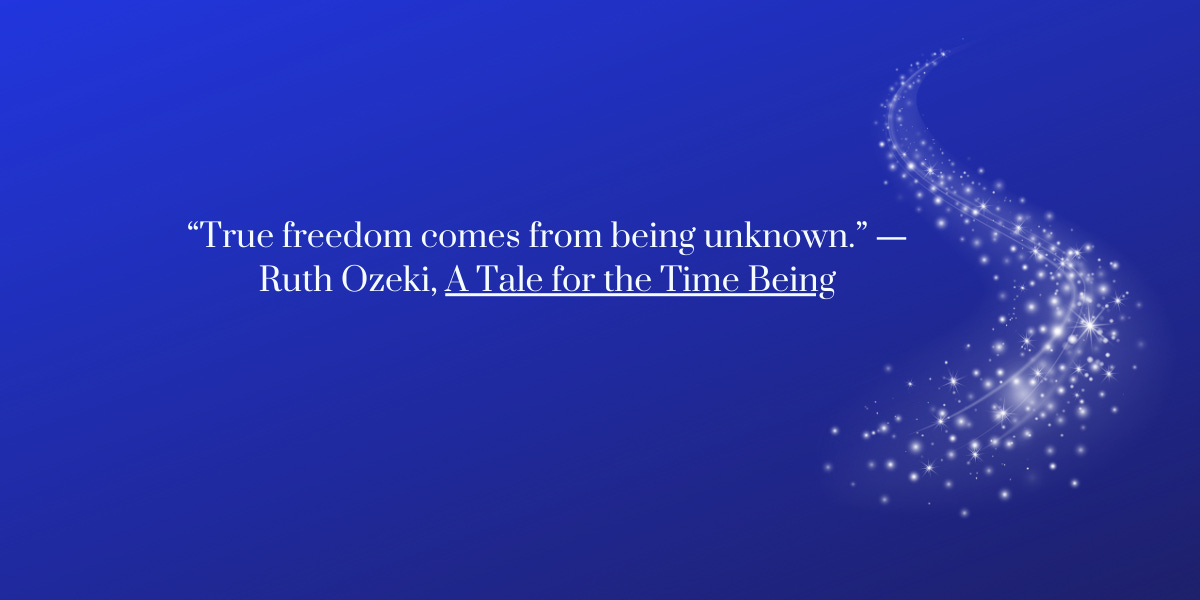Before we begin…
How comfortable are you with what you don’t know? Are you the kind of person who seeks as many facts as possible when confronted with a problem or a decision? Do you love it or hate it when an author finishes a book with an open ending or unanswered questions? Have you ever sought or discovered information only to find that you wished it had remained buried?
Welcome! You’ve reached Spark. Learn more here or just read on. If you received this from a friend, and like what you see, hit that heart above and please join us by subscribing. Invite a friend. It’s free! BTW, if this email looks truncated in your inbox, just click through the headline above now so you can read it all in one go.
Friends,
I stumbled into Ruth Ozeki’s A Tale for The Time Being this week and can’t really climb out even though I turned the last page on Monday night. The very next day I picked it up again and read the appendices, then the acknowledgments, then the last pages again, then some of the pages I’d marked. I have had a difficult time letting go of this story and all that it has made me think about: the nature of time, the possibilities of many worlds in which we are living different lives than the one we are aware of now, Schroedinger’s cat, relationships that exist across time and space, the impossibility of capturing a moment and turning it into words that will convey everything one wants to say. Most pressingly, I am wondering what happened to the girl at the heart of this beautiful, layered novel.
No matter how many times I have dipped back into the book, I emerge with the same uncertainty. I don’t know. I can’t know. I still want to know. I wonder all over again how to coexist with not knowing, which is a much larger question than knowing exactly what happened to the characters in this beautiful novel.
This desire to know has been strong all my life. I like specifics. When a friend once went into a gas station to ask directions, I grilled him unmercifully when I sensed holes in his version. “What exactly did they say?” I asked.
Knowing was a kind of tool or armor. I saw how the kids who knew more than I did were treated by teachers and parents. When I listened to my parents fight, I wanted to understand more about why they were unhappy which in my hopeful heart was the key to fixing it. Every job I’ve had has involved learning about something I do not know and explaining it along with the implications to others. This skill has served me well in my working life. In my personal life, not so much.
Turns out, kids are not meant to fix their parents or anyone, for that matter, and the thrill of being confided in by an adult soon turns to a weight that feels impossible to carry. Similarly, indulging my curiosity about the partners of the men I fell in love with as a young person, usually backfired, leaving me wishing I’d never asked.
Much later in life and only after making mistake after mistake, I’ve finally learned that my need to know is not necessarily echoed among family and friends when it comes to politics, health concerns, or what they should do about their relationships. When it comes to health, for example, my own response to a diagnosis is to research every fact I can find so that I understand all the treatment options, possible outcomes and their likelihood. I want to know enough to speak the language the doctor will use when they talk to me, to be prepared to make decisions. I cling to the idea that this would make a difference in how things go for me. I assume that others share my desire to know, to be armed.
They do not. Or, at the very least, that is not what they want from me. They can do their own research - as much or as little as they want. They want me to be a friend, to support whatever decisions they make, to trust them to absorb and use information in the way that makes sense for them. They want me to sit with them and love them in the face of uncertainty because it is already clear to them what should always have been clear to me: no amount of knowledge replaces the need for a hand to hold in the darkness.
Novels are another matter. I do love novels that challenge me, that make me think but I especially love novels that give me what I cannot have in real life: a sense of order, a logic that flows from a beginning to an end, happy or sad, that makes sense. Ozeki’s novel did not give me a resolution that allowed me to close the book and walk away. Instead, it offered me a set of possible outcomes, each of which are equally possible depending on what we believe about time, space, and relationships. As a result I am still in the thrall of this story. I am still thinking about its people and the possibilities. It is both deeply satisfying and deeply unsettling.
On the surface, A Tale for The Time Being is a simple enough story. A plastic bag with a diary and other fragments of a young Japanese girl’s life wash up on the shores of a remote island in British Columbia. The protagonist, Ruth, opens it and finds a diary addressed, it would seem, to her. Or not. The writer, a sixteen-year-old girl named Nao, can’t know who would ever read it or if anyone ever would. The bag may or may not have been sucked into the ocean by the 2011 tsunami at Fukushima. The diary creates a connection between the two women and Ruth becomes obsessed with learning about Nao, her family, and her story. Ruth can never be sure how Nao’s life turned out, just as she will never know how the bag with its contents arrived on the shores of her home. Time and again, she must grapple with all she does not and cannot know.
We get invested too. It is impossible to read Nao’s diary with Ruth and not want to know how her story ends. She is a tough, vulnerable, funny, insightful, angry, hurt kid who is brutally hazed as an outsider by her Japanese schoolmates and let down by her parents, particularly her father who attempts suicide multiple times. She is also the great-granddaughter of a very old nun, Jiko, who awakens in Nao a sense of herself and offers her a path to survival. We and Ruth follow her to the mountain, not far from Fukushima, to the temple where Jiko lives and Nao learns about her father’s uncle, a student of philosophy who died at 19 after being trained as a kamikaze pilot in the waning days of World War II.
Ruth comes to understand that Nao believes her uncle died a hero of sorts. An honorable man. Yet, hidden in the pages of another booklet contained in the plastic bag containing Nao’s diary, is the story of what Nao’s uncle actually planned to do when he took control of his plane. Now, Ruth has information that Nao does not and could make a difference in what steps she takes next, even whether she chooses to live or die.
Ruth is so immersed in Nao’s story that she wants to save her, help her even though the story she is relating in the diary’s pages happened years earlier. Nao, if alive at the time when Ruth finds the diary, would be in her mid-to-late twenties. This leads to some magical moments involving magical realism in the final quarter of the book in which Ruth may or may not have time-traveled and altered the course of events for Nao. She can never be certain, just as she can never be certain if Nao was caught up in the tsunami or how the plastic bag found its way to her and not someone else. Instead, we are left with the fact that, across the impossibilities of time and space, a relationship has been forged, and the idea that not knowing may mean that all things remain possible. It is this not-knowing, Nao’s ancient great-grandmother says, that is the “most intimate way” to exist with another soul.
This synopsis does little justice to the story Ozeki has written which skillfully weaves questions of philosophy, quantum mechanics, ethics, climate trends, and societal expectations with the hopes, fears, and dreams of human beings grappling with life, death, and the more mundane aspects of getting through a day. It is a beautiful page-turner of a book whose greatest strength may lie in the questions it poses and its willingness to deprive its characters and its readers of complete certainty.
This book found its way onto my TBR list when I read about it in last year’s comments. Thank you to all who suggested it. If anyone would like to talk about this book with me, I’m here for it!!!! Let’s start with the comments and see where we go.
Spark is free but we still need your support. If you like what you see or it resonates with you, please share Spark with a friend and take a minute to click the heart ❤️ below - it helps more folks to find us!
The line that lingers…
This is one of the lines from A Tale for The Time Being that has lingered for me. What does it mean to you?
Here is something else I did NOT know…
I didn’t know that this newsletter would eventually find over 1,000 readers with new ones joining each week. When I started Spark in March of 2020, we were a group of less than 200 readers, writers, or people who, like me, are both. This week we surpassed the 1,000 subscriber mark. Thank you to each and every one of you for being here and for showing me how connection can happen across miles and miles. All it takes is sharing one or two things that we’ve discovered: an idea, a book, story, poem, a question that puzzles us, or something else that might light the path we are walking even for a short distance.
The newsletter has evolved since the early days, thanks to you. I will continue to look to you for ideas to make Spark something you look forward to on Saturday mornings and want to share with others.
In the meantime, the graphic above gives you a glimpse of where your fellow subscribers live and read. And here is a list of posts organized according to the ones you liked best or wanted to talk about the most, much to my surprise in many cases. In fact, you never fail to surprise me with your stories, your insights, and your perfectly-timed book recommendations.
For those of you who are new, here are some direct links to some of the most popular Spark posts:
Who are we without work?, a look at how work does or does not define us with a nod to Bartleby
My nose knew, the olfactory wars and some reads to go with them
What is the middle? Part I and What is the middle Part II, when does middle age begin and when does it end? A collaboration with Lisa Renee of The Long Middle.
When it comes to a life, does size matter? , what is a “big life” anyway?
The Weight, caregiving - it’s not a question of if something will happen, it’s a question of when
And here is the quote that inspires what we are doing here, exploring and sharing those “little daily miracles, illuminations, matches struck unexpectedly in the dark.”
Welcome New Subscribers!
If you’ve just subscribed, thank you so much for being here. If you would like to check out past issues, here’s a quick link to the archives. Be sure to check out our Resources for Readers and Writers too where you will find links for readers, book clubs, writers, and writing groups. And if you’d like to browse for your next read, don’t forget to check out books by authors in our community at the Spark Author Page which will be updated with new names and books very soon. Another great source: the many wonderful reviews you’ll find among the #Bookstackers.
That’s it for this week. Let me know you are and what you’re reading. If there’s an idea, book, or question you’d like to see in an upcoming issue of Spark, let us know! Use the comment button below or just hit reply to this email and send your message directly.
And remember, If you like what you see or it resonates with you, please share Spark with a friend and take a minute to click the heart ❤️ below - it helps more folks to find us!
Ciao for now.
Gratefully,
Betsy
P.S. And now…your moment of Zen: a hummingbird, a sunflower, and being in the right place at the right time
This week’s Moment of Zen comes from Kathy B. who was simply trying to capture the face of one of the sunflowers she loves and associates with summer. She writes, “On a day when I was taking a picture of a newly opened sunflower, a hummingbird zipped into the picture for a quick snack!”
Calling for Your Contribution to “Moment of Zen”
What is YOUR moment of Zen? Send me your photos, a video, a drawing, a song, a poem, or anything with a visual that moved you, thrilled you, calmed you. Or just cracked you up. This feature is wide open for your own personal interpretation.
Come on, go through your photos, your memories or just keep your eyes and ears to the ground and then share. Send your photos/links, etc. to me by replying to this email or simply by sending to: elizabethmarro@substack.com. The main guidelines are probably already obvious: don’t hurt anyone -- don’t send anything that violates the privacy of someone you love or even someone you hate, don’t send anything divisive, or aimed at disparaging others. Our Zen moments are to help us connect, to bond, to learn, to wonder, to share -- to escape the world for a little bit and return refreshed.
I can’t wait to see what you send!
And, in case you missed it, here’s the heart to click on to let us know you’re on board. Every “like” helps others find us!











I'll have to check this book out. I loved The Book of Form and Emptiness, which is very much a meditation on the nature of things and objects. Also, congrats on 1,000 subscribers!
Congrats on hitting 1,000 subscribers! Very well deserved.